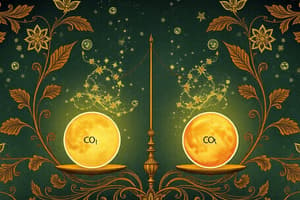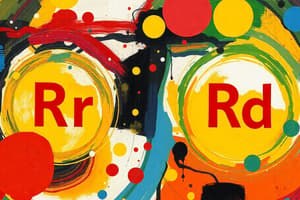Podcast
Questions and Answers
In a redox reaction, the substance that loses electrons is called the ______.
In a redox reaction, the substance that loses electrons is called the ______.
reducing agent
Oxidation always occurs at the ______.
Oxidation always occurs at the ______.
anode
The ______ is the electrode where reduction occurs in an electrochemical cell.
The ______ is the electrode where reduction occurs in an electrochemical cell.
cathode
Reduction occurs at the ______.
Reduction occurs at the ______.
In a voltaic cell, chemical energy is converted into ______ energy.
In a voltaic cell, chemical energy is converted into ______ energy.
In a voltaic cell, the flow of electrons is from the ______ to the cathode.
In a voltaic cell, the flow of electrons is from the ______ to the cathode.
The electrode where oxidation takes place is called the ______.
The electrode where oxidation takes place is called the ______.
The salt bridge allows for the flow of ______ ions between half-cells.
The salt bridge allows for the flow of ______ ions between half-cells.
The build-up of hydrogen bubbles on the anode can increase the ______ of the cell.
The build-up of hydrogen bubbles on the anode can increase the ______ of the cell.
Primary cells are also known as ______ cells.
Primary cells are also known as ______ cells.
Secondary batteries can reverse the chemical reaction that generates ______ by applying an electric current.
Secondary batteries can reverse the chemical reaction that generates ______ by applying an electric current.
In an electrolytic cell, electrical energy is converted into ______ energy.
In an electrolytic cell, electrical energy is converted into ______ energy.
In a primary cell, the reactions are ______ and cannot be reversed once all materials are used.
In a primary cell, the reactions are ______ and cannot be reversed once all materials are used.
Reactive metals from group 1 and 2 can act as ______ agents in redox reactions.
Reactive metals from group 1 and 2 can act as ______ agents in redox reactions.
The electrochemical cell that allows reactions to be reversed is called a ______ cell.
The electrochemical cell that allows reactions to be reversed is called a ______ cell.
The reaction in a lead-acid battery is a type of ______ reaction.
The reaction in a lead-acid battery is a type of ______ reaction.
Electrolytic cells convert electrical energy into chemical energy through a process called ______.
Electrolytic cells convert electrical energy into chemical energy through a process called ______.
In an electrolytic cell, electrons flow from the negative terminal to the ______.
In an electrolytic cell, electrons flow from the negative terminal to the ______.
The electrode that undergoes reduction in an electrolytic cell is called the ______.
The electrode that undergoes reduction in an electrolytic cell is called the ______.
A standard hydrogen electrode (SHE) has a potential defined as ______.
A standard hydrogen electrode (SHE) has a potential defined as ______.
In voltaic cells, the flow of electrons occurs from the ______ to the cathode.
In voltaic cells, the flow of electrons occurs from the ______ to the cathode.
The ease of oxidation and reduction of a species is measured by its standard ______ potential.
The ease of oxidation and reduction of a species is measured by its standard ______ potential.
The electrolyte in an electrolytic cell contains free-moving ______ and anions.
The electrolyte in an electrolytic cell contains free-moving ______ and anions.
In the reactivity series, species more negative than hydrogen will have a greater ease in ______.
In the reactivity series, species more negative than hydrogen will have a greater ease in ______.
Flashcards
Electrochemical Cell
Electrochemical Cell
A device that converts chemical energy into electrical energy through redox reactions.
Anode
Anode
The electrode where oxidation occurs (loss of electrons).
Cathode
Cathode
The electrode where reduction occurs (gain of electrons).
Cell Diagram
Cell Diagram
Signup and view all the flashcards
Salt Bridge
Salt Bridge
Signup and view all the flashcards
Polarization
Polarization
Signup and view all the flashcards
Primary Cell
Primary Cell
Signup and view all the flashcards
Secondary Cell
Secondary Cell
Signup and view all the flashcards
Electrolytic Cell
Electrolytic Cell
Signup and view all the flashcards
Electrolyte
Electrolyte
Signup and view all the flashcards
Standard Electrode Potential (E)
Standard Electrode Potential (E)
Signup and view all the flashcards
Standard Hydrogen Electrode (SHE)
Standard Hydrogen Electrode (SHE)
Signup and view all the flashcards
More Negative E
More Negative E
Signup and view all the flashcards
Bipolar Plate
Bipolar Plate
Signup and view all the flashcards
Balancing Redox Reactions in Acidic Solutions
Balancing Redox Reactions in Acidic Solutions
Signup and view all the flashcards
Balancing Redox Reactions in Neutral or Basic Solutions
Balancing Redox Reactions in Neutral or Basic Solutions
Signup and view all the flashcards
Relative Reactivity of Halogens as Oxidizing Agents
Relative Reactivity of Halogens as Oxidizing Agents
Signup and view all the flashcards
Relative Reactivity of Group 1 Metals as Reducing Agents
Relative Reactivity of Group 1 Metals as Reducing Agents
Signup and view all the flashcards
Redox Reactions of Acids and Metals
Redox Reactions of Acids and Metals
Signup and view all the flashcards
Mechanism of Electron Transfer in Redox Reactions
Mechanism of Electron Transfer in Redox Reactions
Signup and view all the flashcards
Activity Series in Electrochemical Cells
Activity Series in Electrochemical Cells
Signup and view all the flashcards
Study Notes
Oxidation and Reduction
- Oxidation and reduction can be defined in several ways, including by oxygen gain/loss, hydrogen loss/gain, or electron transfer.
- Oxidation is the combination of a substance with oxygen.
- Reduction is the removal of oxygen from a substance.
- Oxidation is the loss of electrons.
- Reduction is the gain of electrons.
- The oxidation state represents the charge an atom would have if the compound were composed of ions.
- If a compound is oxidized, its oxidation state increases. This causes another species to reduce, making it a reducing agent.
- If a compound is reduced, its oxidation state decreases. This causes another species to oxidize, making it an oxidizing agent.
Half-equations
- Redox reactions can be separated into oxidation and reduction half-equations.
- This helps balance redox reactions.
- Steps for balancing redox reactions:
- Identify oxidized and reduced species.
- Separate into oxidation and reduction half-equations.
- Balance the equations, ensuring the number of electrons is equal.
- Add balanced half-equations and cancel electrons.
- In acidic solutions, add H₂O to balance oxygen and H⁺ to balance hydrogen.
- In neutral or basic solutions, add OH⁻ to balance oxygen and H₂O to balance hydrogen.
- Example: 2Na + Cl₂ → 2NaCl. The half-equations are Na → Na⁺ + e⁻ and Cl₂ + 2e⁻ → 2Cl⁻.
Relative Ease of Oxidation/Reduction
- Halogens can act as oxidizing agents. Reactivity increases going up the group
- Group 1 metals can act as reducing agents. Reactivity increases going down the group.
Redox reactions of acids and metals
- Reactive metals, such as those in Groups 1 and 2, readily oxidize with strong acids, producing a salt and hydrogen gas.
Electrochemical Cells
- Electrochemical cells interconvert electrical and chemical energy.
- Types of electrochemical cells include primary (voltaic), secondary (rechargeable), and fuel cells.
- Chemical energy is converted to electrical energy in these cells.
Electrolytic Cells
- Electrolytic cells convert electrical energy into chemical energy.
- Oxidation and reduction are not spontaneous in these cells and require an external electrical source. (electrolysis)
- Electrolytic cells consist of a single container filled with an electrolyte (ionic salt solution) and electrodes placed within the electrolyte.
- A DC electric current is applied to the electrodes.
Case Studies
- Lead-acid batteries: These batteries utilize a chemical reaction involving lead, lead(IV) oxide, and sulfuric acid. The reaction releases energy on discharge and can be reversed (recharged) using electricity.
- Lithium-ion batteries: These batteries include lithium atoms embedded in a graphite electrode and a lithium-cobalt oxide cathode. They utilize a reversible chemical reaction that can be recharged.
Fuel Cells
- Fuel cells convert chemical energy (fuel and oxygen) directly into electrical energy and water.
- Various fuels like hydrogen, methanol, and ethanol are used.
Oxidation and Reduction of Organic Compounds
- Various reactions involving organic components.
Standard Electrode Potentials
- It defines the ease of oxidation/reduction of substances under standard conditions.
- A standard hydrogen electrode (SHE) has a potential of 0V.
- Species with more negative reduction potentials are more easily oxidized.
- Standard cell potential (E°cell) equals the potential of the cathode minus the potential of the anode.
- A positive E°cell indicates a spontaneous reaction.
Gibbs Energy and Standard Cell Potential
- Gibbs free energy change (∆G°) is related to the standard cell potential through the equation ∆G° = -nFE°cell (where n is the number of electrons transferred and F is Faraday's constant.)
- Positive E°cell leads to negative ∆G°, a spontaneous reaction.
Electrolysis of Aqueous Solutions
- Electrolysis involves a non-spontaneous redox reaction powered by an external electrical power source.
- In aqueous solutions, water itself can be oxidized or reduced depending on the potential of the cation/anion.
- Water may be the species oxidized or reduced ahead of the ion involved. Oxidation/reduction of water will take place at the electrode.
Electroplating
- Electroplating is a process where material is transferred from one electrode (anode) to another (cathode) by electrolysis.
Studying That Suits You
Use AI to generate personalized quizzes and flashcards to suit your learning preferences.




